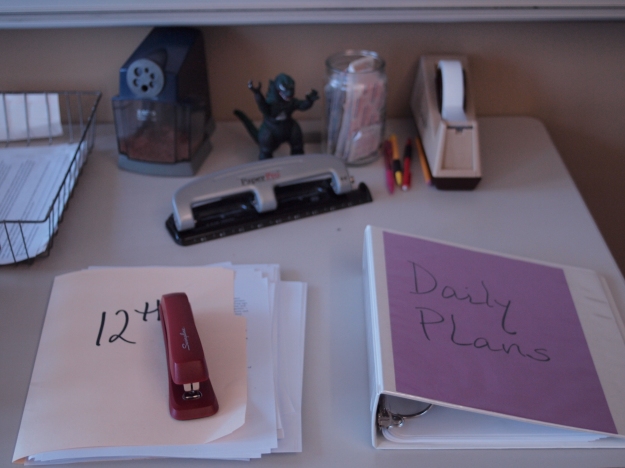5.3 Managing Classroom Procedures through Performance of Noninstructional Duties: Efficient systems for performing noninstructional duties are in place, resulting in minimal loss of instructional time. Effective classroom procedures allow teachers to focus on instruction and students to focus on learning by clearly defining how administrative tasks are taken care of and who is responsible for them. Wong (2009) states, “The effective teacher is able to organize a well-managed classroom where students can learn in a task-oriented environment” (p. 80). When teachers create clearly defined systems for gathering materials, collating work papers, and beginning class, students are able to take responsibility for and proceed independently with their own learning work.
At the school in which I intern there is a teacher who is a master of classroom organization. I observed this teacher’s 9th Grade Honors Language Arts class; she also teachers 12th Grade AP Language Arts. When students enter this teacher’s classroom they pass by a table that has everything they need to prepare for that day’s activities. Here is a photo of that table:

Tools that enable students to organize for learning
Before class begins, students check the master notebook (labeled “Daily Plans”) to see which handouts they need and what assignments are due. Materials are contained in the file folders (marked by grade level) to the left, and a three-hole punch, stapler, tape and writing instruments are readily available. There are two baskets (one per grade level) for turning in assignments. Students take the materials they need and organize their individual notebooks in accordance with the teacher’s model. As materials and tools are nearby and visible, students do not waste time searching for paperwork or office supplies. Since students are responsible for retrieving and organizing class paperwork, the teacher is able to devote class time to high quality instruction rather than administrative details. A Godzilla action figure and jar of band-aids reminds students that the teacher is caring and has a sense of humor, in addition to having high expectations for student self-responsibility.
Because this teacher has clear procedures for entering the room and preparing materials, class began on time, with every student on task. While students wrote possible applications and meanings of the Latin roots figo or fixum in their logbooks the teacher took role and briefly previewed the schedule for the upcoming week. These administrative tasks did not interrupt the students’ vocabulary-building work, and they were prepared to share strong examples of words formed using those roots that demonstrated diverse and nuanced meanings of “to fix, fasten, or attach.” After creating a class list of these words, which students could then record in their logbooks, the teacher remarked, “Oh, that’s Root 24. At Root 25 we do some review and then we have a test. Here’s what that looks like…” The teacher only needed to spend about one minute describing the test; her clear routines for logbook organization, starting class, and recording daily root words and vocabulary work meant students were well-prepared for the upcoming assessment.
Throughout the class I increased my understanding of how physical organizational systems can maximize student learning during a lesson. During a discussion about literary techniques, for example, the teacher said, “On page 203 there is an allusion. How many of you are familiar with that word? If you are not familiar with it, it is conveniently located on page number one of your vocabulary section.” By helping students set up a well-organized logbook and having routines for learning and recording vocabulary, the teacher enabled students to quickly define a word necessary for understanding the text, and provided natural pay off for following her procedures. While watching and listening to a podcast on satire, the teacher stopped at pertinent points to have students write down a definition of satirical techniques, such as exaggeration. Since they keep well-organized logbooks, students will be able to refer back to those definitions in future discussions of satirical techniques, consolidating their learning through repetition and reapplication of terms.
One particular aspect of physical organization in the classroom that I would like to learn more about is effectively handling student paperwork, particularly when collecting and returning assignments. I usually collect in-class writing work as students leave, thanking them as they hand it to me. Often I return graded papers at the end of class, while students are packing up. I like the personal contact with students over their important writing work, but I think it would be more efficient and less chaotic to set up routines that make students fully responsible for getting their assignments to the “turn in” basket and for collecting their graded work when it is ready. This might also allow me to briefly address common writing issues and praise observed writing progress, rather than spending the last few minutes of class distributing graded work.
Reference: Wong, H. & Wong, R. (2009) The First Days of School: How to Be an Effective Teacher Mountain View, CA: Harry K. Song Publications, Inc.
